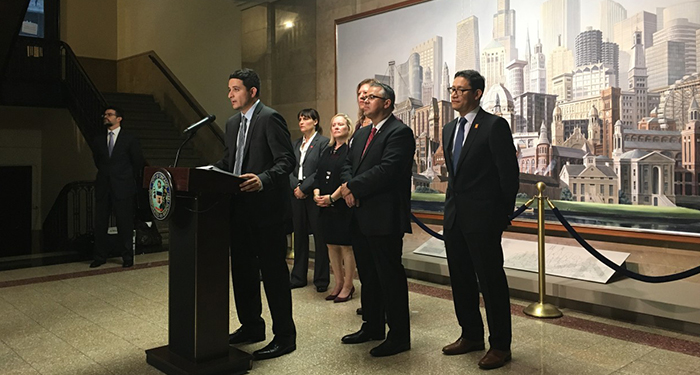
Report author José Acosta-Córdova said that Latinos lag behind other groups when it comes to homeownership and education. PHOTO: MAURICIO PEÑA, CHICAGO MAGAZINE
We were very proud to collaborate with the Institute for Research on Race and Public Policy (IRRPP) to produce a report for Metropolitan Family Services on Chicago’s Latino neighborhoods. On October 11, 2017, The Chicago City Council Latino Caucus, led by Alderman Gilbert Villegas, held a Press Conference to Announce the Release of the report titled: The Latino Neighborhoods Report: Issues and Prospects for Chicago.
The report, based primarily on U.S. Census data, provided citywide data and focused on twelve neighborhoods with at least 25,000 Latino residents where they are the largest single group. The author of the report, José Miguel Acosta-Córdova, is a research assistant for IRRPP, a Master’s student in UIC’s Urban Planning and Policy Program, is President of LPODER (Latino Planning Organization for Development, Education and Regeneration) and is also a James J. Stukel Student Fellow with the Great Cities Institute. It was our pleasure, as part of the James J. Stukel Fellows Program and our mentorship work with students, to assist in making this research more widely available.
While the report was produced for Metropolitan Family Services to assist them in their delivery of social services, it is our hope that other social services agencies, policy makers, regional planning agencies, researchers, and neighborhood groups will be able to use the data in the report to assist them in their work of serving Latino communities in Chicago.
The following is taken directly from the report:
Among the report’s findings:
-
- The Latino population has increased substantially and is widely distributed throughout Chicago neighborhoods.
- Current levels of education for Latinos lag behind White and Black populations.
- Income levels of Latinos lag behind non-Hispanic White populations citywide but Latinos have higher median household incomes in 5 of 12 predominantly Latino neighborhoods.
- Latino neighborhoods have higher concentrations of their labor force in manufacturing and typically low paying service industries and lower concentrations in higher paying service industries.
- Low rates of Latino homeownership and high rates of foreclosures challenge wealth-building and neighborhood stability in many Latino neighborhoods.
- All 12 of the Latino neighborhoods of study had higher rates of their population without health insurance than in the city of Chicago.
This data suggest directions for policy makers. The increasing Latino population is critical to the future of the region. It will be beneficial for the city of Chicago to enact policies and allocate resources to enhance successful strategies and meet critical challenges, particularly in the areas of direct services, education, and employment opportunities that will more effectively integrate Latinos into the formal political, social, and economic fabric of the City.
-
- The growing presence and distribution of Latinos throughout the Chicago region is cause for both celebration and preparation as they also grow in importance to the region’s economy.
- To address lower rates of educational attainment, which limits employment opportunities, continued investments in early childhood education, high school completion, access to higher education and adult education are key elements for further success of Latinos in Chicago.
- Preparing Latinos for high-paying existing and emerging industries through training and education will help close income disparities seen in Chicago.
- Given that Latinos have traditionally played a role in Chicago’s manufacturing sector and continue to have large numbers in this industry, efforts should be made to expand pathways to employment and ownership in Chicago’s reviving manufacturing sector while enhancing access to professional and related services occupations.
- Promoting home and business ownership is a key strategy for building wealth and stability in Chicago’s Latino neighborhoods.
- Improving the insured rate for Latinos is imperative for positive mental and physical health outcomes and will ensure that families are not left with financial burdens.
In the final section, “Issues and Prospects Facing Latinos in Chicago” applying the data, the report addresses education, household income and poverty, employment and industry, homeownership, and health coverage.
A range of media outlets have written about The Latino Neighborhoods Report:


